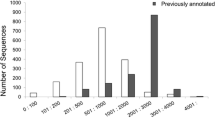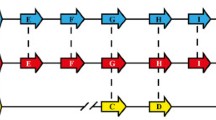Abstract
The surface of the parasitic protozoanTrypanosoma brucei spp. is covered with a dense coat consisting of a single type of glycoprotein molecule, the variant surface glycoprotein (VSG). There may be as many as 1,000 genes for VSG within the genome ofT. brucei, and the switch of expression from one to another is the phenomenon of antigenic variation. As an approach to understanding the evolution of VSG genes we have determined the genomic DNA sequences of the eight genes encoding the variant surface glycoprotein 117 (VSG) family. From these data we have observed a number of features concerning the relationships between these genes: (1) there is a region of high variability confined to the N-terminus of the coding sequence, and comparison of the sequences with the available X-ray diffraction crystal structures suggests that two of the most variable stretches within the N-terminal domain are present on surface-exposed loops, indicating a role for epitope selection in evolution of these genes; (2) the 29 nucleotides surrounding the splice acceptor site are absolutely conserved in all eight 117 VSG genes; (3) numerous insertion/deletion mutations are located within or immediately downstream of the C-terminal protein-coding sequences: (4) within 500 by downstream of the insertion/deletion mutations are one or two copies of a repeat motif highly homologous to the recombinogenic 76-bp repeat sequences present upstream of many VSG basic copy genes and the expression-linked copy.
Similar content being viewed by others
Abbreviations
- BC:
-
basic copy
- ELC:
-
expression-linked copy
- ES:
-
expression site
- GPI:
-
glycosylphosphatidylinositol; indel, mutation where insertion or deletion cannot be discriminated; (k)bp, (kilo)base pairs
- ORF:
-
open reading frame
- URS:
-
upstream repeat sequence (also known as 76-bp repeats)
- UTR:
-
untranslated region
- VSG:
-
variant surface glycoprotein. The nucleotide sequences presented in this paper have been submitted to GeDBank with the following accession numbers; pSUB85, L31608; pSUB70C, L31607; pSUB70A, L31606; pSUB60, L31605; pSUB55, L31604; pSUB52, L31603; pSUB50, L31602 and the 117 basic copy (pGB 117), L34415
References
Allen G, Gurnett L (1983) Location of the six disulphide bonds in a variant surface glycoprotein (VSG117) from Trypanosoma brucei. Biochem J 209:481–487
Aline RF, Myler PJ, Gobright E, Sturat KD (1994) Early expression of aTrypanosoma brucei VSG gene duplicated from and imcomplete basic copy. J Euk Microbiol 41:71–78
Barbet AF, Kamper SM (1993) Importance of mosaic gene expression to survival ofTrypanosoma brucei. Parasitol Today 9:63–66
Beals TP, Boothroyd JC (1992a) Genomic organization and context of a trypanosome variant surface glycoprotein gene family. J Mol Biol 225:961–971
Beals TP, Boothroyd JC (1992b) Sequence divergence among members of a trypanosome variant surface glycoprotein gene family. J Mol Biol 225:973–983
Bernards A, Van der Ploeg LHT, Frasch ACC, Borst P, Bothroyd JC, Coleman S, Cross GAM (1981) Activation of trypanosome surface glycoprotein genes involves a gene duplication-transposition leading to an altered 3′ end. Cell 27:497–505
Blum ML, Down JA, Gurnett AM, Carrington M, Turner MJ, Wiley DC (1993) A structural motif in the variant surface glycoproteins ofTrypanosoma brucei. Nature 362:603–609
Boothroyd JC, Cross GAM (1982) Transcripts coding for variant surface glycoproteins ofTrypanosoma brucei have a short, identical exon at their 5′ end. Gene 20:281–289
Boothroyd JC, Paynter CA, Coleman SL, Cross GAM (1982) Complete nucleotide sequence of cDNA coding for a variant surface glycoprotein ofTrypansoma brucei, J Mol Biol 157:547–556
Borst P, Cross GAM (1982) Molecular basis for trypanosome antigenic variation. Cell 29:291–303
Campbell DA, van Bree MP, Boothroyd JC (1984) The 5′-limit of transposition and upstream barren region of a trypanosome VSG gene: tandem 76 base-pair repeats flanking (TAA)90. Nucleic Acids Res 12:2759–2774
Cross GAM (1990a) Cellular and genetic aspects of antigenic variation in trypanosomes. Annu Rev Immunol 8:83–110
Cross GAM (1990b) Glycolipid anchoring of plasma membrane proteins. Annu Rev Cell Biol 6:1–39
Devereux J, Haeberli P, Smithies O (1984) A set of sequence analysis programs for the VAX. Nucleic Acids Res 12:387–395
Freymann D, Down J, Carrington M, Roditi I, Turner M, Wiley DC (1990) A resolution structure of the N-terminal domain of a variant surface glycoprotein fromTrypanosoma brucei. J Mol Biol 216: 141–160
Hasan G, Turner MJ, Cordingley JS (1984) Complete nucleotide sequence of an unusual mobile element fromTrypanosoma brucei. Cell 37:333–341
Holder AA (1985) Glycosylation of the variant surface antigens ofTrypanosoma brucei. Curr Top Microbiol Immunol 117:57–74
Hsia R-C, Beals TP, Boothroyd JC (1996) Use of chimeric recombinant polypeptides to analyze conformational, surface epitopes on trypanosome variant surface glycoproteins. Mol Microbiol 19:53–63
Kamper SM, Barbet AF (1992) Surface epitope variation via mosaic gene formation is potential key to long-term survival ofTrypanosoma brucei. Mol Biochem Parasitol 53:33–44
Kimmel BE, Ole-Moiyoi OK, Young JR (1987) Ingi, a 52-kb dispersed sequence element fromTrypanosoma brucei that carries half of a smaller mobile element at either end and has homology with mammalian LINEs. Mol Cell Biol 7:1465–1475
Komfeld R, Kornfeld S (1985) Assembly of asparagine-linked oligosaccharides. Annu Rev Biochem 54:631–664
Lamont GS, Tucker RS, Cross GAM (1986) Analysis of antigen switching rates inTrypanosoma brucei. Parasitology 92:355–367
Liu AYC, Van der Ploeg LHT, Rijsewijk FAM, Borst P (1983) The transposition unit of VSG gene 118 ofTrypanosoma brucei: presence of repeated elements at its border and absence of promoter associated sequences. J Mol Biol 167:57–75
Longacre S, Eisen H (1986) Expression of whole and hybrid genes inTrypanosoma equiperdum antigenic variation. EMBO J 5:1057–1063
Lu Y, Hall T, Gay LS, Donelson JE (1993) Point mutations are associated with a gene duplication leading to the bloodstream reexpression of a trypanosome metacyclic VSG. Cell 72: 397–406
Maniatis T, Sambrook J, Fritsch J (1985) Molecular cloning: a laboratory manual, 1st ed. Cold Spring Harbor Press, Cold Spring Harbor, NY
Olafson RW, Clarke MW, Kieland SL, Pearson TW, Barber AF, McGuire T (1984) Amino terminal sequence homology among variant surface glycoproteins of African trypanosomes. Mol Biochem Parasitol 12:287–298
Pays E, Vanhamme L, Berberof M (1994) Genetic controls for the expression of surface antigens in African trypanosomes. Annu Rev Micro 48:25–52
Roberts SC, Swihart KG, Agey MW, Ramamoorthy R, Wilson ME, Donelson JE (1993) Sequence diversity and organization of the msp gene family encoding gp63 ofLeishmania chagasi. Mol Biochem Parasitol 62:157–172
Smiley BL, Aline RF, Myler PJ, Stuart K (1990) A retroposon in the 5′ flank of aTrypanosoma brucei VSG gene lacks insertional terminal repeats. Mol Biochem Parasitol 42:143–152
Swafford DL (1993) Phylogenetic Analysis Using Parsimony, Version 311. Illinois History Survey, Champaign, IL
Thon G, Baltz T, Eisen H (1989) Antigenic diversity by the recombination of pseudogenes. Genes Dev 3:1247–1254
Thon G, Baltz T, Giroud C, Eisen H (1990) Trypanosome variable surface glycoproteins: composite genes and order of expression. Genes Dev 9:1374–1383
Van der Ploeg LHT (1990) In: Hames BD, Glover DM (eds) Genome rearrangement. Oxford University Press, Oxford
Van der Ploeg LHT, Valerio D, De Lange T, Bemards A, Borst P, Grosveld FG (1982) An analysis of cosmid clones of nuclear DNA fromTrypanosoma brucei shows that the genes for variant surface glycoproteins are clustered in the genome. Nucleic Acids Res 10: 5905–5923
Vickerman K (1989) Trypanosome sociology and antigenic variation. Parasitology 99:537–547
Author information
Authors and Affiliations
Additional information
Correspondence to: J.C. Boothroyd
Rights and permissions
About this article
Cite this article
Field, M.C., Boothroyd, J.C. Sequence divergence in a family of variant surface glycoprotein genes from trypanosomes: Coding region hypervariability and downstream recombinogenic repeats. J Mol Evol 42, 500–511 (1996). https://doi.org/10.1007/BF02352280
Received:
Accepted:
Issue Date:
DOI: https://doi.org/10.1007/BF02352280




